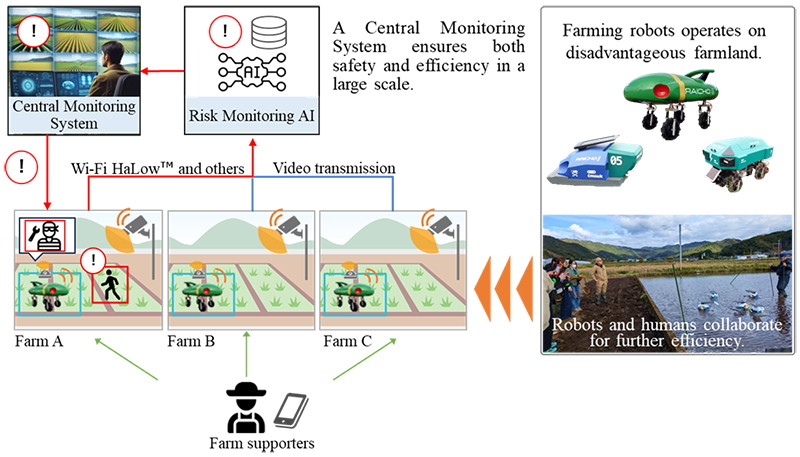Top of Page
- Links to move inside this page.
- HOME
- About IIJ
- News / CSR
- Press Releases
- 2025
- Launching a Pilot Project for Labor-Saving Rice Farming Support Services Utilizing Agricultural Robots, Wireless Communications, AI, and Other Advanced Technologies
Launching a Pilot Project for Labor-Saving Rice Farming Support Services Utilizing Agricultural Robots, Wireless Communications, AI, and Other Advanced Technologies
Establishing a sustainable rice cultivation model that reduces the abandonment of rice cultivation in disadvantageous farmland, such as mountainous terrain
July 23, 2025
Internet Initiative Japan Inc.
tmsuk company limited
Pulsiv8 Inc.
Koyawata, Inc.
TOKYO – July 23, 2025 - Internet Initiative Japan Inc. (TSE Prime: 3774, IIJ), tmsuk company limited (tmsuk), Pulsiv8 Inc. (Pulsiv8), and Koyawata, Inc. (Koyawata) today announced to launch a pilot project in June 2025 to develop labor-saving rice farming support services that utilize wireless communications, robots, and other technologies to enable the use of disadvantageous farmland, such as small-scale farms and irregularly shaped farms, in mountainous regions and other difficult-to-farm areas. This pilot project is taking place in the city of Nobeoka, Miyazaki Prefecture, among other locations. This project has been adopted by the Ministry of Internal Affairs and Communications for its Regional Society DX Promotion Package Project (Advanced Wireless System Application Type). The results of this project will be used to promote efforts that support labor-saving rice cultivation in farmland where sustained cultivation is in jeopardy with the goal of contributing to sustainable rice cultivation in mountainous regions.
Background
Due to the recent sharp rise in the price of rice, interest in agriculture — ensuring rice production volume and sustained rice cultivation in particular — has increased. While the aging of farmers and human labor shortages become major issues, farmers are being encouraged to increase the size of their farms and farmland as a means of ensuring rice production volume. At the same time, however, there are many farms and farming areas that are unsuited to large-scale farming. In particular, when it comes to disadvantageous farmland that is small, irregularly shaped, or difficult to access with farming machinery, such as farmland in mountainous regions, it is difficult to improve efficiency and production volume through mechanization and automation. Such farmland often lacks farmers who are willing to take it over, and it becomes abandoned as a result. Under these circumstances regarding the state of disadvantageous farmland, the amount of abandoned farmland (idle farmland) in Japan sits at about 423,000 hectares (according to the 2015 Agriculture and Forestry Census).
This project is developing and testing support services for labor-saving rice cultivation in disadvantageous farmland through the use of wireless communications, agricultural robots, and other advanced technologies. Through this pilot project, it is aimed to establish a sustainable rice cultivation model for disadvantageous farmland that is unsuitable for large-scale cultivation and prevent further increases in abandoned farmland by creating an environment that ensures a certain amount of profit along with labor-saving measures and by working with the local community to procure farmers and to apply new farming methods that can reliably produce results.
Overview of the Demonstration Experiment
For this demonstration experiment, the project team will operate small agricultural robots that can be deployed on small farms, and video footage of its operational status will be transmitted using wireless technologies, such as Starlink satellite communications and Wi-Fi HaLow™.(*) The robots will be operated and monitored remotely, and a system that can use AI to detect the robots' operational status and nearby hazards will be adopted. The project will verify the system's operation and evaluate the practicality and labor savings for tasks that can be performed by robots in place of human workers. Furthermore, in collaboration with the City of Nobeoka where the project is taking place, the Kitauramachi Agricultural Development Corporation, and Kyushu University, this project will evaluate how well these technologies balance labor savings with crop yields through new approaches to rice cultivation that include double-cropping, dry rice cultivation, and hiring local residents to perform agricultural work.
- (*)Wi-Fi HaLow: A Wi-Fi standard characterized by long communication distances, low power consumption, and good radio wave penetration.
Project Overview
| Demonstration period | June 2025 – March 2026 |
|---|---|
| Purpose |
|
| Implementation details |
|
| Implementation framework and company-specific roles | Project leader:
Project members:
Project partners:
|
| Verification locations |
|
Overall Structure of the Demonstration System

About IIJ
Founded in 1992, IIJ is one of Japan's leading Internet-access and comprehensive network solutions providers. IIJ and its group companies provide total network solutions that mainly cater to high-end corporate customers. IIJ's services include high-quality Internet connectivity services, systems integration, cloud computing services, security services and mobile services. Moreover, IIJ has built one of the largest Internet backbone networks in Japan that is connected to the United States, the United Kingdom and Asia. IIJ was listed on the Prime Market of the Tokyo Stock Exchange in 2022.
- For more information about IIJ, visit the IIJ Web site at https://www.iij.ad.jp/en/.
The statements within this release contain forward-looking statements about our future plans that involve risk and uncertainty. These statements may differ materially from actual future events or results.
- For inquiries, contact
-
IIJ Corporate Communications
 +81-3-5205-6310
+81-3-5205-6310  +81-3-5205-6377
+81-3-5205-6377  press@iij.ad.jp
press@iij.ad.jp
- (*)All company, product, and service names used in this press release are the trademarks or registered trademarks of their respective owners.
- Related Contents
End of the page.